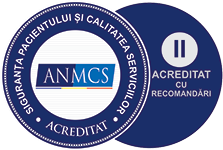We offer 10 days of free treatment with a referral from the specialist.
Principles of physiotherapy action:
- Non Nocere Principle. By this principle, a patient should be in better biological condition at the end of a physiotherapy treatment than at the beginning.
- Holistic Principle. Any physical factor, natural or artificial, addresses the whole body, which also responds as a whole.
- The Individualisation Principle. Any physical therapeutic factor acts non-specifically, from individual to individual. The body is obliged to “respond”, and adapt. These changes are evaluated as therapeutic outcomes.
Physiotherapy, as a complex therapeutic discipline, traditionally comprises several branches:
- hydrotherapy,
- electrotherapy,
- kinesitherapy
- climatotherapy,
- thermotherapy,
- phototherapy,
- massage,
- balneotherapy.
Physiotherapy by means of electrotherapy procedures has important anti-analgesic (pain relief), anti-inflammatory (elimination of joint and muscle inflammation), decontracting (elimination of contractures), myorelaxant (muscle relaxation) effects, antiedematous (elimination of swellings resulting from the infiltration of a serous fluid in a subcutaneous cellular tissue), by means of diadynamic and interferential currents and the application of ultrasound, laser and ultrashort generated by modern devices such as NEMECTRON, NEMECTROSON, BTL-5816 SLM, BTL-20. Physiotherapy is indicated in the recovery :
- orthopedic – effectively benefits weak back muscles, scoliosis and incipient kyphosis in which muscle training is truly achieved – sprains, dislocations, contusions, post-fracture algoneurodystrophy syndrome, accelerated callus, muscle stretching, joint stiffness,
- inactivity muscle atrophyin joint manifestations – styloiditis, epicondylitis, scapulohumeral periarthritis (SHP)
- rheumatological – degenerative – arthrosis (coxarthrosis, gonarthrosis, spondylosis), chronic inflammatory – arthritis, ankylopoietic spondylitis
- neurological – cervicobrachial neuralgia, neuromyalgia, neuritis, algoneurodystrophic syndromes, lumbosciatica, disc disease at various levels of the spine
- local or general damage to collagen tissue – retraction of Dupuytren’s palmar aponeurosis, fibrositis, dermatomyositis
- oncological – pain therapy (pain in carcinomas)
- dermatological – postherpetic neuralgia, pain reminiscent of shingles
- in respiratory disorders – laryngitis, bronchitis, sequelae of non-ubercular pleurisy
- in urogenital disorders – prostatitis, pyelocystitis, prostatic hypertrophy with bladder tenesmus
- in gynaecological disorders – metroanexitis and chronic non-specific parametritis with hypomenorrhoea and amenorrhoea
- in otorhinolaryngological disorders – acute and chronic frontal, frontoethmoidal and maxillary sinusitis, chronic rhinitis, pharyngitis, laryngitis.
Kinetotherapy or “medical gymnastics”, considered to be one of the most important stages of medical recovery, aims to increase muscle strength and endurance as well as joint mobility through specific physical exercises. Kinesitherapy can treat a wide range of conditions, but it is also recommended for healthy people to improve fitness, muscle tone and strength. Kinesiotherapy aims to:
- correcting posture and body alignment – through special physiotherapy techniques such as posturals and muscle toning exercises with a role in orthostasis
- increase muscle strength – through toning exercises with high resistance
- increasing muscular endurance – through toning exercises with a graded progression
- increasing joint mobility – through passive, passive-active and active mobilisations with resistance, as well as through exercises to soften the muscles of the joint in question
- coordination, control and balance – through specific physiotherapy exercises for neurological disorders
- exercise training – through aerobic exercise without a considerable load and with a greater number of repetitions
- respiratory retraining – are kinesiotherapy exercises for training the intercostal and abdominal muscles
- sensitivity re-education – these are physiotherapy techniques that consist of stimulating sensory nerve endings in the affected area.
- relaxation – one of the most effective relaxation methods used in physiotherapy is stretching. This technique stretches the muscles along their entire length, resulting in relaxation, increased elasticity, flexibility and range of motion.
Kinetotherapy is one of the fundamental means on which the rehabilitation of motor impairments is based. According to the way Kinetotherapy is applied, in relation to the other means of rehabilitation, it can be divided into:
- Kinetotherapy of neurosurgical deficiencies: early reduction of infantile encephalopathies, of individuals fractured and immobilized in plaster casts, rehabilitation of deficiencies requiring orthopedic assistance.
- Pre-operative kinetotherapy is carried out before surgery in the case of joint scoliosis, which requires surgical resolution, etc.
- Postoperative kinetotherapy, which is mandatory after all locomotor surgeries, followed or not by orthopaedic assistance or prosthesis.




 Română
Română English
English